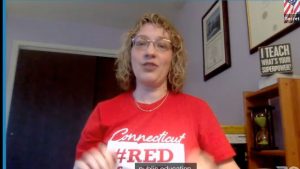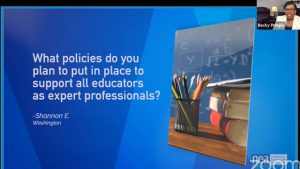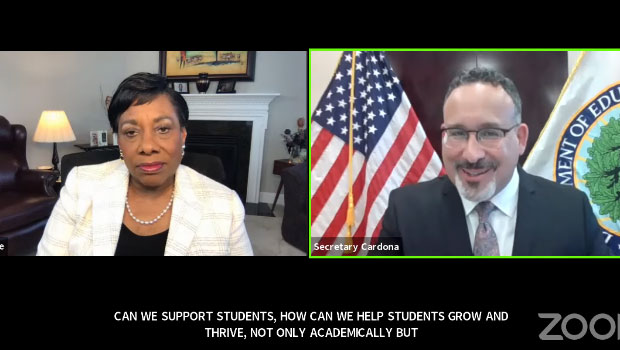“We’re going to heal, learn, and grow together.”
That was the message teachers across the country heard from newly appointed U.S. Education Secretary Miguel Cardona, who sat down for a virtual, livestreamed conversation with NEA President Becky Pringle yesterday evening. Tens of thousands of teachers tuned in to hear Dr. Cardona’s vision for public education as well as ask questions about his plans for standardized tests, relief funding, and more.
The secretary gave a shout-out to CEA leaders Jeff Leake and Donald Williams for their work on crafting sound education policy before and since the pandemic, answered questions from Stratford’s own 2011 Connecticut Teacher of the Year Kristen Record about the future of standardized testing, and addressed topics ranging from education funding to social justice and elevating the teaching profession.
Read excerpts from that conversation and watch the full interview here.
What are your goals as we recover from the pandemic?
Thank you for everything you’ve done this past year—and before the pandemic. You’ve had to switch your job from one day to the next, totally. There is no substitute for in-person learning. When we talk about equity, in-person learning is the best equity lever we can pull right now because of interpersonal relationships with teachers and peer-to-peer interactions, so that is a major goal moving forward.
Gaps existed before the pandemic, since before we even started collecting data, so we have to aggressively and unapologetically address the normalization of failure, where, for decades there’s been a normalized difference in outcomes for students based on place and race.
In education, for far too long we’ve been on defense. It’s time to control the narrative and say, ‘This is what we do for schools, for students, and for communities,’ and honor the teaching profession the way it deserves to be honored. NEA will be a very important part of this work moving forward for the agency and for our country, and I look forward to the collaboration.
Our kids need us now more than ever. Let’s not lose that sense of urgency. We are in a pandemic, and I can think of no other time in our country’s history that we have had an opportunity to hit reset on some things that we know don’t work.
That’s going to take teamwork, and I’m committed to making sure we have NEA’s voice at the table so that we can do the very best for our kids. They deserve it, and they’ve been waiting. The opportunity we have right now is so big. Let’s change the trajectory, especially for our Black and brown students. I look forward to working with you and serving our students the best we can. It’s always about how we can help students thrive not only academically but emotionally.
Given the Biden administration’s commitment to social and racial justice, how will you lead with that, and how will you partner with members of the education community to ensure every student’s access to equitable opportunities and rights?
From day one as an educator, I’ve understood that the smartest person in the room is the room itself, meaning that when you bring people together with different perspectives, you might not always agree, but there’s so much value in listening to diverse perspectives to make sure that whatever you come up with takes into account the feelings, the background, experience, and perceptions of others. The success that I’ve had has been in bringing people together and getting their input into how things are developed and decision-making into the work that we’re doing. That’s what leads to success for our students. We’re keeping our students at the center. As Connecticut’s commissioner of education, when the pandemic hit, and prior to the pandemic, I worked closely with the union leads in Connecticut—Jeff Leake and Don Williams—and we ratcheted that up during the pandemic, because I need teachers at the table. It was a difficult time, but the groups that are most successful invest in relationships—not just in front of the camera but in authentic collaboration, good dialogue, and problem-solving together. I know that’s the right formula.
Over the last year, our students have faced unprecedented challenges. Between losing loved ones, adapting to distancing learning, and missing out on a year of regular social interactions, they’ve had their worlds turned upside down. With the American Rescue Plan, we have an opportunity to reshape public education. One of those opportunities is reimagining how we assess student achievement. Can you share with us how you envision the future of assessments? Stratford physics teacher Kristen Record

Stratford teacher Kristen Record asks U.S. Education Secretary Miguel Cardona about his plans for standardized testing.
Let me be clear. My wife works in two middle schools with over 700 students, and my children attend a public high school with over 1,000 students in it, so those decisions I was making as Connecticut education commissioner were decisions I was making for my own children.
There’s no one-size-fits-all for this. And I will tell you, I remember being a principal at an elementary school with bilingual students learning English—they came from the Dominican Republic, Mexico, Puerto Rico—and they came at a time when we had to administer standardized assessments, so I remember sitting with a young student, Stephanie, taking an assessment and asking myself, ‘Why am I doing this? This makes no sense.’ Thinking about Stephanie, I had to ask, ‘Is this the right approach, given the fact that she just came into the country and doesn’t understand English?’
We’ve evolved a lot since then in terms of language and computer-adaptive tests, but I get it. I get the frustration people feel right now. I get the challenge this is. Right when I came on board as U.S. Education Secretary, we offered flexibilities to try to see where students are, knowing that standardized assessments are not the end-all. No educator needs to see a standardized assessment to know how their kids are doing; let me make that clear. That’s just one data point.
Why are we assessing? Is it helping us improve instruction? Is it helping us learn how we can support students? If it’s not, we really need to take a step back. Unfortunately over the last ten, 20 years, I’ve seen an overreliance on assessments, and what I’ve seen also as an educator is the narrowing of curriculum, or the narrowing of programs, so students who need more STEM, who need more arts and more of those opportunities are getting less of them, because the pedagogy is aimed at preparing for the assessment. We have it backwards.
In really well-done assessments, you shouldn’t even know you’re taking them; they should mirror good instruction. They should be real-time assessments. So there’s a lot of work to be done. I guarantee that’s something we’re going to be discussing to see how we can improve assessments so that they really reflect student learning and honor the teaching profession. There’s work to be done, and I’m eager to do that work. These are conversations I look forward to having, with NEA at the table.
Thanks to President Biden’s leadership, Congress passed the American Rescue Plan, which offers funding for schools in the wake of the pandemic. Now that the money is going to states, how are you working to ensure governors and local school districts are using the funding to best help our students?
We have a president who gets it, and it helps to have a first lady who’s a teacher. There’s a level of urgency coming from President Biden to make sure we get it right and not only recover from the pandemic but address some of those ills that have plagued us for years. Just today we released an application for states to share what their plans will entail, and I want that information to be public. I want you to see it. I want there to be a stakeholder engagement process. I want those plans to have your fingerprints on them. We’re working with governors to ensure that the money is there, and we put out guidance last week to make sure the money supports schools and the students who need it, and that it is not used to supplant funding that would have been there before.
This is unprecedented, the amount of funding going to schools, and we need to be good stewards of that.
The pandemic has put many students behind academically. What will you do to help them get back on track?
I recognize a lot of people during the pandemic are feeling burned, are feeling hurt or pushed aside. Through our actions more than our words I hope that you recognize that this is a new day, and I look forward to working with our teachers. I look forward to listening. We may not always end up at the same spot, but I know what it feels like to be in a classroom and say, ‘Man, I wish people knew this, or I wish they heard this.’ Our job is to support you so that you can be successful at helping children.
Many of our students were significantly affected academically, but in order to get to the academic piece, we have to start with social-emotional well-being. It’s hard to learn if you’re grieving. It’s hard to learn if your teeth hurt. It’s hard to learn if you’re hungry. It’s hard to learn if you’re not sure where you’re sleeping at night. When we welcome our students back, let’s not make the mistake of turning on the lights and thinking just because they have their masks on, let’s turn to page 35. We need to make sure we’re designing our schools to welcome students back after such a traumatic experience—worse for some than others.
And we have to make sure not only our students but our educators are able to come back and their social-emotional well-being guides the decisions that we’re making. First and foremost, that relational piece needs to be addressed. If we get that right, the learning will come, and the acceleration will come.
How are we addressing the needs of our educators in light of the pandemic?

Educators from across the country submitted questions for Dr. Cardona.
We don’t expect our students to just go and catch up, and we can’t expect that of our educators either. So, how are we designing professional learning opportunities so that teachers are not scrambling? There’s funding here for that support. It’s not only about supporting our students for academic success but helping prepare our educators to give those students the resources they need.
Hopefully, after this pandemic, there is a new appreciation for the amazing work that educators do, day in and day out. We need to control the narrative and show how our educators are amazing and meeting students where they are on all levels, and working with families. We need to pay educators what they’re worth. It’s unacceptable in 2021 that teachers have to have a second job because the first job doesn’t pay enough. I was reading recently that in 30 states, mid-career educators with families of four were qualifying for federal assistance, like free and reduced lunch. Mid-career educators. That’s unacceptable. We need to make sure they have a good compensation, that we’re valuing growth opportunities, professional learning opportunities.
This profession, we ask so much of our educators—we’re talking about trauma-informed instruction, we’re talking about formative assessments, we’re talking about blended learning. I want to make sure as we move forward with the American Rescue Plan that some of those resources are aimed at providing opportunities for teachers to have job-embedded professional learning. I’m not talking about 4 to 8 o’clock three nights a week, or those three times a year you cram everything into one. Let’s reimagine what it means to honor the profession by providing job-embedded professional learning. Every other profession does it; it’s about time we started thinking creatively and outside the box. The resources are there. We need to have the will to do it. And I know that’s only going to help our students.







